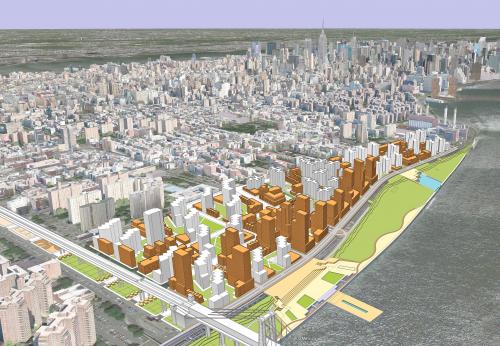
From 'the Projects' to a Sustainable Community: Re-envisioning Public Housing in Lower East Side Manhattan
Location: New York, NY. Neighborhood, District, and Corridor
SITE: 78 acres of existing tower-in-the-park public housing along the Manhattan waterfront
Program: Socially and environmentally sensitive infill of underused green space around existing public housing structures, resulting in zero displacement, improved urban design and an increase in affordable housing stock.
The rapid growth of New York City in recent years has spurred an economic revival, but poses a challenge to continued affordability as increased demand for urban living drives up rents in central areas. In this context, public housing managed by the New York City Housing Authority (NYCHA) is a key bulwark against the displacement of low-income residents from New York neighborhoods. Although demand for affordable housing is high – NYCHA’s waiting list is currently 143,000 applications long – there is very little land for the creation of new affordable housing and diminishing funds for maintenance of the existing stock.
This proposal by Momin Mahammad, which is based on his Master of Urban Design thesis at the University of California, Berkeley, seeks to address this situation by taking advantage of unused development rights on existing NYCHA properties. But rather than fully tearing down and redeveloping the existing buildings, Mahammad’s approach readapts dysfunctional mid-century modern public housing sites into the urban fabric, resulting in no displacement and an increase in the overall housing stock.
The project focuses on three public housing sites on the Lower East Side of Manhattan, which were built between 1949 and 1959. Once part of the fine-grained urban fabric of the surrounding area, the sites were completely razed to build tower-in-the-park style buildings that are physically disconnected from their environment. Ostensibly rich in open space, Mahammad performed a site analysis that identifies much of it as too bare, unwelcoming or windswept to be accessible or usable for residents or visitors. While almost 82% of the project area is currently covered with open space, just under 10% is functional.
This proposal targets the underused land for redevelopment, largely protecting the NYCHA buildings that currently provide much-needed affordable housing for the neighborhood. The current configuration of this open space allows for the New York street grid to be re-extended onto the site, leaving room for new buildings and additions that engage the street. This reinstatement of the grid is not only physical but also programmatic; the plan proposes extending the East Village commercial overlay code into the site to create a continuous active retail frontage.
While the new buildings would enhance the density of uses and users on the site, the plan provides for a variety of built typologies, from multifamily row-houses to Vancouver-style towers, to respond to the existing built environment and natural systems. Buildings are thoughtfully designed and oriented to take advantage of solar and wind energy as well as natural lighting and shading.
In addition, the proposal sets out a network of green spaces that, in contrast to the dysfunctional spaces currently provided, are both ecologically and recreationally valuable for the neighborhood. Urban farms, retention ponds, and bio-swales help accommodate more storm water on site and are situated in active green spaces designed to interact with new and existing buildings as well as the surrounding network of well-used parks.
The proposal is well attuned to the realities of implementation. Recognizing the importance of New York’s zoning code to the reinvigoration of NYCHA housing, Mahammad identifies specific exemptions and designation changes that would be required to carry out the Lower East Side project. Further, while the plan dedicates a majority of its 3,200 new units to affordable housing—in the form of senior units, income-restricted units, and new public housing—1,120 units are designated as market-rate units to cross-subsidize the new affordable stock.
Juror Mike Lydon praised the project for its careful analysis and design as well as its implications for other NYCHA sites, stating that Mahammad “brings forward an idea of leveraging an incredible amount of wasted land that could be made productive and livable for the city.” The plan demonstrates how targeted but visionary interventions can reintegrate key urban assets such as affordable housing into the urban fabric.
PRESS: DOWNLOAD HI-RES PROJECT IMAGES HERE
Transect Zone(s): T5 center, T6 core.
Status: Proposed
Project or Plan's Scale: Neighborhood
Features: Affordable/subsidized housing, Bus transit, Live/work, Mixed uses, Sustainable infrastructure, Transit oriented development, Waterfront.
Land area (in acres): 78
Total built area (in sq. ft.):
Total project cost (in local currency):
Retail area (in sq. ft.):
Office area (in sq. ft.):
Industrial area (in sq. ft.):
Number of hotel units:
Number of residential units (include live/work):
Parks & green space (in acres):
Residential types: High-rise, Mid-rise/loft.
Project team designers: Momin Mahammad a masters student at the University of California Berkeley
Project team developers: N/A
Previous site status: Redevelopment
Starting/Ending date of construction/implementation: -




